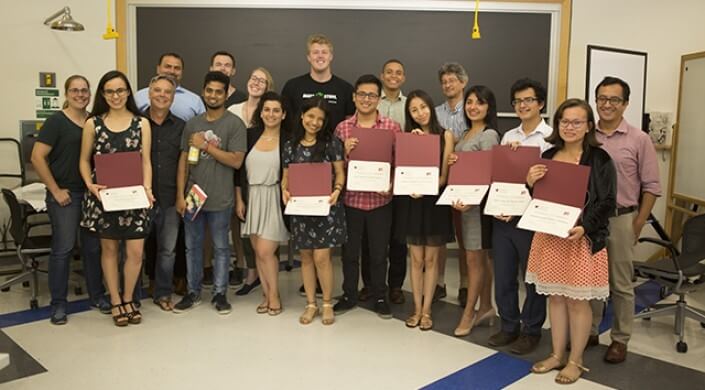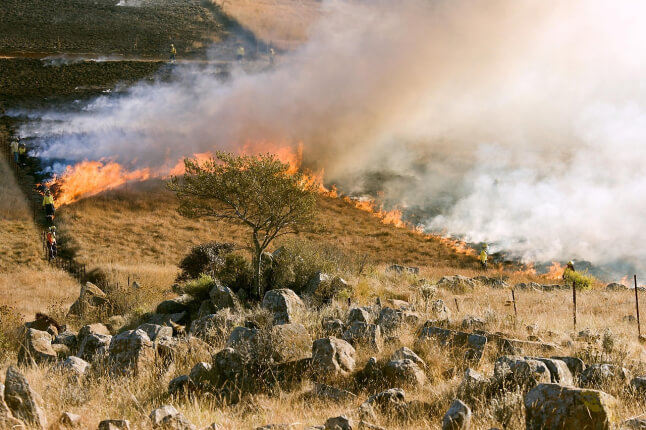News
Students from Universidad de Ingeniería y Tecnología (UTEC) and SEAS collaborated this summer to develop a soil-testing device to improve agriculture in a remote region of the Peruvian rainforest. (Photo by Adam Zewe/SEAS Communications)
In Madre del Dios, a remote region deep in the Peruvian rainforest, deforestation and mercury pollution from illegal gold mining threaten the health of the ecosystem and the local population.
More than 300,000 hectares of rainforest (an area slightly larger than Rhode Island) have been devastated over the past 30 years and about 40 tons of mercury is dumped into the environment annually. But illegal mining provides vital economic support for about 60,000 people in one of Peru’s poorest regions.
Students from the Harvard John A. Paulson School of Engineering and Applied Sciences (SEAS) and Universidad de Ingeniería y Tecnología (UTEC) tackled this complex problem with a unique solution—by developing a device to improve agriculture.
Rice, corn, pineapples, and papayas are grown throughout the region, but agriculture in Madre del Dios is manual and uses outdated equipment, leading to high crop mortality rates.
SEAS and UTEC students explore the remote region of Madre del Dios by boat, traveling down the Amazon River.
“Illegal mining is a very profitable operation, but it is really stripping the land and contaminating the area,” said Bryant Huggins, S.B. ’19, a mechanical engineering concentrator. “If we can make farming more efficient and lucrative, then hopefully we will be able to draw people away from illegal gold mining into more environmentally sustainable practices.”
Building off a project started by a group of students in January, Huggins and mechanical engineering concentrator Dennis Zhang, S.B. ’18, traveled to Lima in July to collaborate with UTEC peers on a soil-testing device.
Funding from the U.S. State Department enabled program directors Joost Vlassak, Abbott and James Lawrence Professor of Materials Engineering, and UTEC engineering professor Carlos Alfredo Rios Perez to expand the January program, during which students conceived three solutions to address environmental problems in Madre del Dios. After consulting local non-governmental organizations, Vlassak and Perez selected the soil-testing device for further development.
Mechanical engineering concentrator Bryant Huggins, S.B. ’19 (right) and UTEC student Anarea Alvarez Veva collaborate to test the circuits for the team’s microfluidic device. (Photo by Adam Zewe/SEAS Communications)
In Lima, Huggins, Zhang, and the UTEC engineering students created a spectrometry device to analyze the phosphorus level in soil. Phosphorus is essential for agriculture because it helps plants utilize nutrients.
“That test provides a good jumping-off place to be able to start fertilizing the land or looking at crop rotation,” Huggins said. “Right now, the process has been more history-based; farmers just keep doing what worked in the past, but they don’t know how their soil might have changed over time, or if they are even growing the optimal crops for the soil they have.”
The students took their prototype to Madre del Dios, where they gathered feedback from farmers and learned about the challenges of integrating the device into agricultural processes that have been ingrained into the culture for generations.
The farmers were enthusiastic about the prototype, Huggins said, but implementing the device widely could be very difficult since the chemicals used in the soil test are costly and require special permits in Peru.
In Peru, the students from SEAS and UTEC collaborated to develop this soil-testing spectrometry device, being held by UTEC engineering professor Carlos Alfredo Rios Perez.
To overcome this challenge, Huggins and the UTEC students traveled to Cambridge, where they collaborated in the SEAS Active Learning Labs to develop a microfluidic device that could perform the same soil analysis. Microfluidic tests use only a few drops of chemicals, reducing the cost of the device and making it easier to implement.
As the team carefully conducted chemical tests, Jose Martin Paredes Santus, a UTEC senior majoring in industrial engineering, said it was challenging to combine chemistry, with which he is less familiar, with physics and math.
UTEC students learn how to use the equipment in the SEAS Active Learning Labs. (Photo by Adam Zewe/SEAS Communications)
“But the biggest challenge moving forward will be making this device easy for farmers to use,” he said. “They are people who lack formal education. Helping them to understand the importance of this problem, and how our device can solve it, is critical.”
Working with cutting-edge equipment at SEAS was a great learning experience for Elena Ezquerra, a UTEC senior majoring in energy engineering. She enjoyed collaborating with her peers on a project that could actually make a difference.
“It is rewarding to help people who are almost abandoned in the Amazon,” she said. “We have the knowledge and resources to make a difference. It is really satisfying to give them something to help their situation.”
Moving forward, Vlassak is working to have the microfluidic device incorporated into a senior thesis project, enlisting an engineering student to refine the device, develop additional chemical tests, and prepare it to be deployed in the Amazon. A team of students at UTEC may continue developing additional spectrometry devices for other soil tests.
The SEAS/UTEC collaboration, now in its fifth year, is a unique way to give students real-world engineering experience, said Vlassak.
“The students developed a lot of hands-on technical knowledge and learned an enormous amount about chemistry. But beyond that is the fact that they are more aware of social issues,” he said. “These are not simple problems with simple solutions. And when you actually do come up with a solution, you must work with stakeholders to make sure it is something that can actually be implemented.”
The students met with farmers in Madre del Dios to learn about the agricultural challenges they face and how their device could be utilized most effectively.
For Huggins, the prospect of implementing a solution to help people in need is inspiring, and something he hopes to continue in his career as an engineer.
“A lot of times, we think of engineering as having to be groundbreaking technological research that does something new and exciting, but sometimes it can just be figuring out how to implement the technology we already have in places or for people who don’t have access to it,” he said. “It is not always a question of what’s next, but looking at what we have and how we can use it to help people.”
Topics: Environment
Cutting-edge science delivered direct to your inbox.
Join the Harvard SEAS mailing list.
Press Contact
Adam Zewe | 617-496-5878 | azewe@seas.harvard.edu



